China is known for its rich cultural heritage and the diversity of its traditional arts and crafts. Among the many fascinating aspects of Chinese culture is the use of xiangbao, also known as sachets or fragrance sachets. These small, intricately designed cloth pouches filled with fragrant materials have a long history in Chinese tradition and continue to be valued for their aesthetic appeal and symbolic meanings.
what is Chinese sachet bags?
Sachet is a small pouch traditionally carried by the Han ethnic group in China to hold miscellaneous items. It has evolved into a symbol of love and affection. The patterns on the pouch can be intricate or simple, featuring flowers, birds, animals, insects, landscapes, figures, auspicious phrases, poems, and other textual elements, all with rich decorative meanings.
Xiangbao, also known as “Rongchou,” “Xiangdai,” “Hebao,” “Xiangnang,” “Xiangying,” or “Peishai,” is a type of folk embroidery craft created by laboring women in ancient China. It is a product of the agricultural culture of ancient China, symbolizing the division of labor between men and women in farming. It is a cultural heritage and revival of traditional Chinese culture that has persisted for thousands of years.
The earliest term for Xiangbao was “Rongchou,” mentioned in the poem “Li Sao” by Qu Yuan, which includes the line “Hujiang liyu bichi xian, ran qiu lan yiwei pei.” The fragrances used in ancient times were “bichi” and “qiu lan.” The term “Rongchou” was still in use during the Ming Dynasty. Traditional Chinese Xiangbao is often made of silk or fabric and filled with fragrant materials such as realgar, xiangcao (a type of herb), and Artemisia leaves. It is believed that Xiangbao can ward off evil spirits, and it is often hung as an accessory during the Dragon Boat Festival.
Chinese sachets are popular embroidered handicrafts that are prevalent among various ethnic groups, including the Han, Tujia, Manchu, Ewenki, Mongolian, and Daur. The designs and forms vary across different regions. Some common types include “Wudu” (Five Poisonous Creatures), tigers, wrapped palm with colorful threads, wrapped threads, auspicious lotus-shaped sachets, etc. They can also be crafted into small chickens, flowers, birds, insects, or symbolic motifs such as longevity peaches, bats (symbolizing fortune), and mandarin oranges (symbolizing good luck). Sachets can also be used as pendants for lanterns, musical instruments, or folding fans, or they can be transformed into needle cases, tobacco pouches, or parts of eyeglass pouches. Sachets are typically filled with fragrant herbs and spices, which possess mosquito repellent and antibacterial properties. It is a common folk tradition to wear sachets during the Dragon Boat Festival to ward off evil spirits and calamities. In some areas, sachets are filled with tobacco or fire tongs. Young women often use sachets as tokens of love by embroidering pairs of mandarin ducks or love messages on them, expressing their pursuit of love. In recent years, sachets have gradually entered people’s diverse lives. For example, artisans in Chaozhou, Guangdong Province have explored the production of various toy-like sachets, which are exported domestically and internationally, adding a modern touch to this ancient folk craft.
Bai embroidery is another type of embroidered handicraft popular among the Bai ethnic group in Dali, Yunnan. Originally used for Buddhist purposes, it has evolved into daily-life items and decorations. Typically, the embroidered shoulder bag measures around 33 centimeters in length and 23 centimeters in width. It consists of a bag, a long cover, colorful tassels on the corners, and a colorful fabric strap. The patterns, colors, and embroidery techniques of the sachets vary depending on the age of the user.
In 2008, Xiangbao was included in the first batch of the National Intangible Cultural Heritage expansion project list.

history of Chinese sachet
Thesachet, also known as “xiangbao,” “peiwei,” “rongchou,” “xiangdai,” or “hebao,” is a traditional Chinese embroidered craft. It is made by embroidering various intricate patterns and designs on colored silk fabric. These patterns vary in shape, size, and complexity, and can depict flowers, birds, animals, insects, landscapes, figures, auspicious phrases, poems, and other cultural symbols. Thesachet is filled with finely ground aromatic herbs and serves as both a practical and ornamental item for seasonal celebrations, practical use, and aesthetic enjoyment.
The concept ofsachet can be traced back at least 3,000 years, as mentioned in some poems of the Book of Songs (Shijing). The Book of Rites (Liji) states that the colors used in the embroidery ofsachet symbolize different meanings. The colorful silk threads used in the embroidery make thesachet visually appealing and serve as decoration for clothing, as well as a means to appreciate its aesthetic value. Filled with special herbal fragrances,sachet also acts as a means to repel evil spirits and provide a refreshing sensation. The Book of Rites also mentions that young boys and girls, before reaching adulthood, were required to wearsachet as part of their ritualistic attire, indicating its ceremonial significance. During the Warring States period and the Qin, Han, and Jin dynasties, both men and women woresachet. However, it gradually became exclusively used by women and children after the Jin dynasty. In the Song dynasty, officials began wearingsachet as part of their ceremonial attire, further highlighting its ceremonial role. In the Qing dynasty,sachet became a popular gift, particularly as a token of love between romantic partners. Today,sachet serves as a carrier of traditional culture, playing an irreplaceable role in interpersonal communication, beautifying the environment, nurturing sentiments, and conveying positive wishes. By gifting asachet, one can convey friendship, uplift spirits, and express good wishes, as it encompasses rich cultural connotations and spiritual significance.
On the other hand, the term “荷包” (hebao), which refers to “wallet” in modern Cantonese, originally had a different meaning. In ancient times, people didn’t have pockets in their clothing, so they used small bags likehebao to carry essential items such as handkerchiefs, seals, and coins. The earliesthebao were hand-held or shoulder-carried bags, which were later hung at the waist, giving rise to the term “旁囊” (pangnang).hebao was commonly made of leather, hence the name “囊” (nang). For example, ahebao made of sheepskin was discovered in the ancient tomb of Su Ba Shi in Shanshan County, Xinjiang. It had a rectangular shape, measuring 6.7 cm in length and 3.7 cm in width, and featured a leather strap for hanging. The earliest survivinghebao dates back to the Spring and Autumn period.
During the Dragon Boat Festival, which falls on the fifth day of the fifth lunar month,sachet plays an important role in the traditional customs. Due to limited medical advancements in ancient times, people ground aromatic herbs such as mugwort, realgar, and calamus into powder and stored them in cloth pouches worn on the chest. The fragrant aroma emitted from thesesachet was believed to repel insects and ward off evil. This marked the origin ofsachet as a protective item during the festival.
Originally,sachet was simply a fabric pouch containing aromatic substances. However, as women in ancient times excelled in needlework,sachet craftsmanship became increasingly refined and visually captivating. The delicate embroidery work onsachet, created stitch by stitch, conveys a profound sense of affection. Offeringsachet as a gift carries a warm sentiment that cannot be replaced by a simple greeting card.
sachet, also known as香囊 (xiangnang),馨香 (xinxiang), and香袋 (xiangdai), has a long history of evolution. In traditional customs,sachet was believed to have the power to dispel evil spirits and bring good luck. Over time, the customs of warding off evil and seeking blessings merged, resulting in the creation ofsachet — a small fabric pouch filled with fragrant herbs such as mugwort, realgar, and sandalwood powder.sachet serves as a protective charm and symbolizes longevity. It has become a traditional symbol of auspiciousness and goodwill. The craftsmanship ofsachet, as seen from surviving examples since the Qing dynasty, primarily features floral and animal motifs, using metaphorical symbols to express various emotions and aspirations. For example, paired fish, butterflies, and dragons represent love, union, and fertility, while lotus flowers, water lilies, peonies, and plum blossoms symbolize femininity. Birds playing among plum blossoms and bees collecting nectar further represent masculinity. Other motifs include cranes for longevity and pomegranates for numerous offspring. The clever use of homophones in Chinese characters is also evident, such as combining jujubes, peanuts, longan fruit, and lotus seeds to represent “early childbirth” as a gift for newlyweds, or using cats and butterflies to symbolize an interesting and enjoyable old age for presenting to elderly people.
Peeling back these layers of cultural heritage, we encounter a wealth of artistry that reflects human desires, conveys thoughts and beliefs, and showcases the vitality of life.sachet represents genuine folk culture, popular customs, and the essence of human nature.
In modern Cantonese, hebaocommonly refers to a wallet. In ancient times, when people wore loose clothing without pockets, they usedhebao to carry essential items. As time passed,hebao evolved into a small bag used for carrying money and other miscellaneous items.
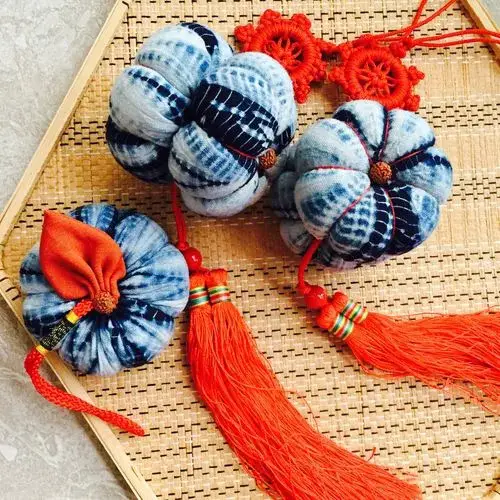
when was the first Chinese sachet?
The history ofsachet making and wearing can be traced back to at least the Warring States period. In the poem “Li Sao” by Qu Yuan, it is mentioned, “Hu Jiangli and Pi Zhi, thread Qiu Lan as adornment.” Hu Jiangli, Pi Zhi, and Qiu Lan are all aromatic herbs. The term “thread” refers to the act of connecting or stringing together. “Adornment” refers to wearing asachet or something similar. The sentence conveys the meaning of wearing asachet filled with aromatic herbs. This indicates thatsachet was already a form of decoration during the Warring States period.
Origin 1: In the past, when people stayed in the wilderness, they used leaves to wrap medicinal herbs to prevent snake bites. Gradually, this practice evolved into using cloth and silk, turningsachet into a decorative and auspicious item.
Origin 2:sachet was used as a means to convey military secrets and letters during marches and warfare. It was known as “jin nang” or “locket.” In the Three Kingdoms period, the item used to carry secret letters in Zhuge Liang’s “ingenious plan in a locket” given to Zhao Yun was asachet.
Origin 3: In families with unmarried daughters, when constructing a pavilion facing the street, windows were opened on all sides. When selecting a husband, the woman would go up to the pavilion and throw asachet to the person she was interested in as a token of affection.sachet contained aromatic herbs such as Xixin, Baizhi, Dingxiang, Gansong, and Cangzhu, which emitted a pleasant fragrance and also had the function of removing impurities and warding off evil.
According to etymology, the character “香” (xiang) consists of the “he” radical, representing the sprouting of crops, and the “yang” radical, representing the sun. Therefore, the meaning of香 (xiang) implies that all things grow with the help of the sun.香 (xiang) represents life and vitality.sachet and the art of fragrance embody this essence.
Chinesesachet is not merely an embroidery piece. Let us reexamine the history, cultural significance, and artistic value ofsachet from a historical and modern perspective.
ancient Chinese sachet
The tradition of wearing sachets in China has a long history. According to the “Book of Rites” (Li Ji), it is recorded: “When serving parents, one wears the right and left matching accessories… the ‘Jin Ying’ (a type of sachet) is worn to show respect to parents and uncles and aunts. Boys and girls who have not yet reached adulthood wear the ‘Rong Xiu’ (another term for sachet) during grooming rituals, with the Jin Ying attached to the collar.” This passage refers to the knotted sachets and the fragrant substances contained within them. It indicates that during the Zhou Dynasty, young people would carry sachets with them as a sign of respect for their elders, rather than for decorative purposes.
The earliest discovered sachets can be traced back to the Han Dynasty, specifically the Mawangdui Han Tomb No. 1 in Changsha. Four sachets were unearthed from this tomb, and they were relatively large in size, featuring an exquisite embroidery technique known as “Xin Qi Xiu,” which was highly sophisticated in terms of weaving and embroidery craftsmanship during the Western Han Dynasty.
During the Tang and Song Dynasties, the art of making sachets greatly developed. In 1950, a gold sachet with twin dragons was unearthed in Xuan Cheng, Anhui Province. It measured 7.8 centimeters in height, 6.5 centimeters in width, and weighed 30 grams. It was made by hammering two gold plates together, with a mother-and-child clasp. The sachet was intricately carved on both sides with twin dragons, depicted with raised heads, open mouths, curved bodies, and tails curled upwards, displaying agility and vitality. The edges of the sachet were embroidered and engraved with patterns of leaves and interlocking circles, adding a strong decorative element. At the top, there was a circular hole for wearing and hanging.
During the Yuan, Ming, and Qing Dynasties, the variety of sachets and their popularity increased. In the Qing Dynasty, it was fashionable for both the imperial family and officials to wear sachets and carry them as accessories. Sachets also gained popularity among the general population in ancient times.
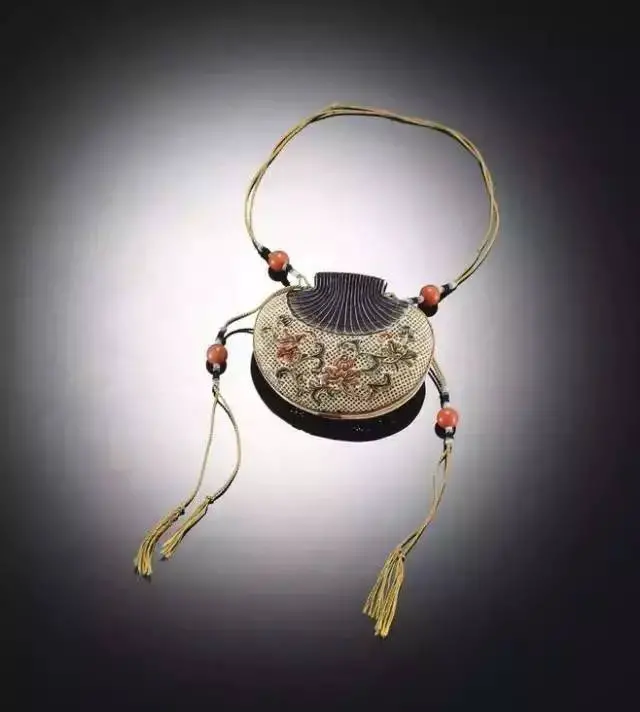
style of Chinese sachet
Thesachet has a long history, and the tradition of wearingsachet during the Dragon Boat Festival still exists today. Throughout its development from ancient times to the present,sachet has evolved into various types based on different classification methods:
Shape: There are various shapes such as round, square, oval, wajiao-shaped, gourd-shaped, pomegranate-shaped, peach-shaped, waist-shaped, fangsheng-shaped, triangular, and more.
Purpose:sachet can be classified according to its purpose, such as mosquito-repellentsachet, evil-wardingsachet, fragrancesachet, epidemic-preventingsachet, and deodorizingsachet.
Material:sachet can be made of various materials, including gold thread embroidery, silver thread embroidery, inlaid with jadeite, and silk embroidery. In ancient times,sachet was also made of metal, serving not only as a fragrance but also providing warmth to the hands.
Suitable for different age groups:sachet designed for older people often feature shapes like plum blossoms, chrysanthemums, lotus flowers, or intertwined double lotus, symbolizing good luck.sachet for children usually incorporate patterns of tigers, leopards, or monkeys, representing intelligence, strength, and good health.sachet worn by young people often serve as a means to express their sentiments. When exchanging gifts between young lovers, women would often presentsachet handcrafted by themselves, conveying their affection and showcasing their craftsmanship.
Based on their functions,sachet can be categorized as follows:
Mosquito-repellentsachet: Thesesachets are made of herbs such as Atractylodes, Dahurian Angelica, Ligusticum Chuanxiong, Notopterygium, Saposhnikovia, Lavender, and Camphor. They have a strong and long-lasting aroma.
Snake-repellentsachet: Thesesachets are made of realgar, musk, borneol, Atractylodes, cloves, and Ligusticum Chuanxiong. The strong fragrance emitted by thesesachets can repel snakes from a distance.
Epidemic-preventingsachet: Thesesachets are made of Atractylodes, Patchouli, Artemisia, Evodia, realgar, borneol, and camphor. They have a warm and fragrant aroma and are effective in warding off harmful gases.
Purifyingsachet: Thesesachets are made of Patchouli, Peh-Lan, Dahurian Angelica, Amomum, Calamus, Atractylodes, and Artemisia. They have a pleasant and non-drying fragrance, purifying the air.
Room air purificationsachet: Renowned physician Hua Tuo used cloves, hundreds of other medicinal herbs to createsachets that were hung in living spaces to prevent respiratory diseases.
Evil-wardingsachet: Somesachets contain a small amount of cinnabar, which has been believed to possess the power to ward off evil spirits.
Furthermore, some ethnic minorities usesachets made from local materials. During the blooming season of various flowers in spring and summer, Manchu women, for example, place fragrant flowers like Magnolia, Jasmine, Dianthus, Rose, and Moon Orchid insachets and wear them to enjoy the scent.
Mostsachets contain volatile oils, which have a pleasant and long-lasting aroma. Many traditional Chinese herbs have effective components that can inhibit or eliminate various bacteria, viruses, and fungi to different extents, thus serving the purpose of avoiding evil and preventing epidemics. This is why there is a poem saying, “Wearingsachet on the body, hanging Artemisia above the door, eliminating all plagues, and bringing auspiciousness.”
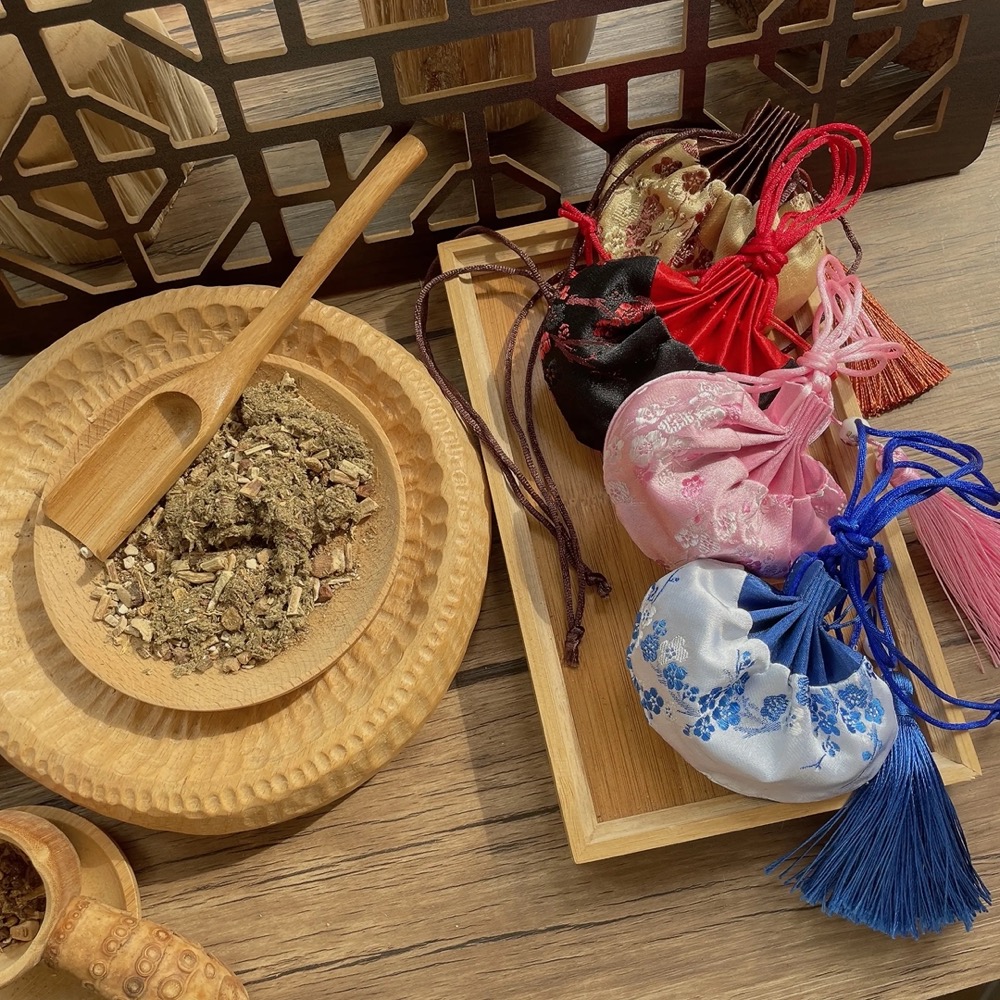
qingyang sachet
Qingyang sachet embroidery is a local traditional handicraft in Qingyang City, Gansu Province, China. Various patterns are embroidered with colorful threads on silk fabric, which are then sewn into different shapes and filled with silk cotton and fragrances, creating delicate and beautiful embroidered items. These embroidered items are called sachets or purses, locally known as “shua huo zi,” and they serve as ancient folk objects during the Dragon Boat Festival in Qingyang, representing the local people’s desire to ward off evil, avoid disasters, and pray for blessings.
Qingyang sachets are exquisite embroidered treasures with a long and rich history. They are crafted with unique artistic concepts, skilled embroidery techniques, refreshing natural fragrances, and vibrant colored threads. The diverse and elegant designs of Qingyang sachets express people’s worship of totems, their desire for good luck and protection from evil, as well as their wishes for blessings, longevity, prosperity, love, and a better life.
There are five main types of Qingyang sachets:
Head-worn sachets: These are mainly worn by children, featuring various animal-shaped caps such as tiger, cat, and rabbit. They are worn during the Dragon Boat Festival for protection against evil.
Shoulder or sleeping sachets: These often depict fierce tigers and lions, embroidered in a way that the head appears large while the body is small and without legs. They are sewn onto children’s shoulders to ward off evil spirits.
Chest-hanging sachets: These come in a wide variety of styles and contents. Multiple sachets are connected using colorful threads and hung on the front buttons of clothes. The patterns often represent auspicious animals and plants, conveying women’s wishes for blessings, abundance, and prosperity.
Back-carrying sachets: These are primarily known as the “Five Poisonous Animals” back vests. The embroidered patterns include poisonous snakes, scorpions, lizards, spiders, and centipedes. Despite being toxic creatures, they are worn on children’s clothing on the Dragon Boat Festival, symbolizing the ancient philosophical concept of “using poison to counteract poison” and the desire for personal protection.
Foot-worn sachets: These often feature the heads of flying birds and running animals, such as tiger head shoes, cat head shoes, and butterfly shoes. These sachets are symmetrical, with one sachet for each foot. In ancient philosophy, the left foot represents yang and the right foot represents yin. This design signifies the balance of yin and yang, warding off evil, and the symbolism of pairs and galloping hooves.
The traditional patterns of Qingyang sachets can be broadly classified as follows:
Heaven and Earth, Yin and Yang: Representing the sun as yang, the moon as yin, with the upper part representing yang and the lower part representing yin. Symbolic patterns include the rising sun over the sea, expressing people’s hopes for a righteous ruler and incorruptible officials.
Auspiciousness and Prosperity: Expressing people’s wishes for a prosperous and auspicious life. Examples include sachets with the auspicious character “fu” (fortune) or patterns of seasonal flowers with a coin in the center, symbolizing wealth throughout the year. There are also sachets featuring bats (representing good fortune), deer (representing prosperity), and the character “shou” (longevity), representing good fortune and longevity.
Love and Reproduction: Depicting symbols of love, such as fish swimming around lotus flowers or phoenixes playing with peonies. They also include magpies perched on plum branches, symbolizing joyous events. Some sachets depict mice nibbling grapes, symbolizing fertility.
Qingyang sachets are made using simple materials and techniques. They are crafted with silk or colorful fabrics, embroidered with various colored threads. The sachets not only possess external beauty but also emit a pleasant fragrance. The choice of fragrances varies depending on the decorative needs. Sachets can be filled with fragrances that have soothing effects, refreshing scents, or the enchanting aroma of roses. Sachets of different fragrances can be made into sachet pillows, car ornaments, or various styles of tokens for romantic relationships.
The craftsmanship of Qingyang sachets combines three-dimensional shaping with flat embroidery, resulting in four main types: “chu chu” sachets, thread plate sachets, three-dimensional embroidered sachets, and flat embroidered sachets.
The history of sachets can be traced back more than 2,300 years to the time mentioned in the famous ancient Chinese medical book “Huangdi Neijing.” During that time, sachets were used for epidemic prevention and protection against snake venom, employing a method known as “fumigation.” This method gradually became a local custom, with herbs being called “fragrant herbs” and the medicine bag transforming into a “sachet.”
In the Warring States period, the famous Chinese poet Qu Yuan mentioned “fragrant sachets” in his poem “Li Sao,” indicating that sachets were already used as decorative items during that era.
During the Han Dynasty, the Book of Rites mentioned that young boys and girls should wear “rong xiu,” which refers to sachets. This indicates that sachets were worn by unmarried boys and girls during that time.
By the Tang and Song Dynasties, sachets had evolved into two types: sachets and purses. Sachets gradually became exclusive accessories for women and beauties, while purses were mainly used to carry small handkerchiefs and valuables.
During the Ming and Qing Dynasties, Qingyang sachets flourished and became popular items for wearing or gifting. They were also associated with love during that period.
In recent times, sachets have mainly been used as traditional gifts during the Dragon Boat Festival, serving the purposes of seeking blessings, warding off evil, and praying for good fortune. In the past two decades, the production and embroidery of sachets have experienced a revival. In 2002, Qingyang City was designated as the “Hometown of Sachet Embroidery” by the China Folklore Society.
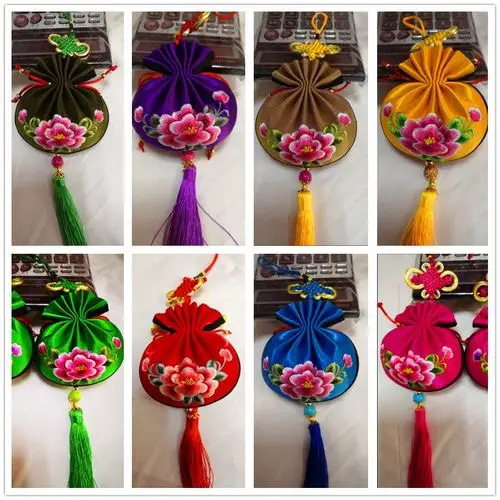
Bai Ethnic Sachets
Bai ethnic sachets are traditional embroidered handicrafts and part of the Bai costume. They are popular in the Dali area of Yunnan province. Originally used as Buddhist items, they have become essential items in women’s daily lives. The sachets are rectangular in shape, measuring 33 cm in length and 23 cm in width. They feature a cover and colorful tassels hanging down, with fabric straps for shoulder-wearing. The sachets made by elderly women are embroidered with lotus flowers, fish, birds, butterflies, and Buddha images. They are adorned with copper bells and silver fish as decorations at the bottom. Sachets made by middle-aged and young women have elegant and graceful color tones, often featuring blue fabric with white thread embroidery, depicting flowers, birds, butterflies, and other designs. Young men use black fabric for their sachets, with embroidered patterns of mountains, flowers, and wild grass on the cover.
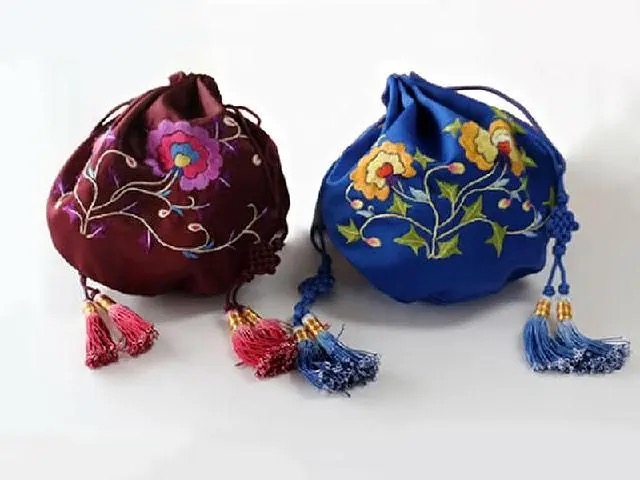
Chaozhou Sachets
Chaozhou sachets are popular handicrafts among rural women, especially young women, in Chaozhou. They have many beautiful legends associated with them. Many women consider sachets as tokens of love, expressing their heartfelt desires through needlework. Sachets are also used as talismans against evil spirits. According to the “Chaozhou Annals,” Chaozhou sachets were originally tokens of love and decorations for young men and women. Chaozhou people like to adorn their rooms, clothes, and objects with beautiful sachets, adding a touch of elegance to the environment. Sachets are also hung on happy occasions in temples and used to praise the deities. During the late Qing dynasty, sachet production transitioned from personal use to commercial production and became increasingly popular and sought after, even exported overseas. Chaozhou sachets are usually handmade, with complex craftsmanship. Creating a fine sachet involves embroidery, cutting patterns, attaching a base, adding gold trimmings, sewing, stuffing, and stringing beads. Each stitch requires skill and technique. The materials used for sachets include silk, satin, gauze, velvet, cloth, gold and silver threads, colored threads, beads, paper, and mirrors. Chaozhou sachets emphasize exaggeration and are rich in folk colors. They come in various types, including sachets for holding different fragrances, needle sachets, zong ball sachets, knot sachets, melon seed chicken sachets, and button sachets. Sachets are also made by nuns as gifts for others. Since the 1950s, professionals have taken an interest in sachet making, contributing to the enhancement and preservation of Chaozhou sachets.
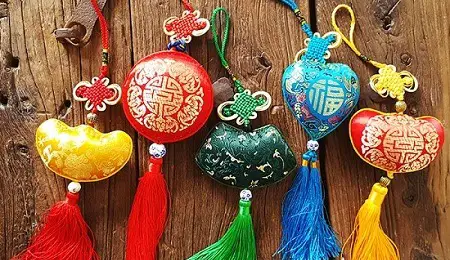
Musk Sachets
Musk sachets are decorations worn by Yi ethnic men in the Daliang Mountains of Sichuan and Yunnan provinces. These small fabric pouches contain musk and are adorned with the fangs of male musk deer. Yi men like to wear them on their chests as decorations, and they are believed to have the power to ward off diseases and repel insects.
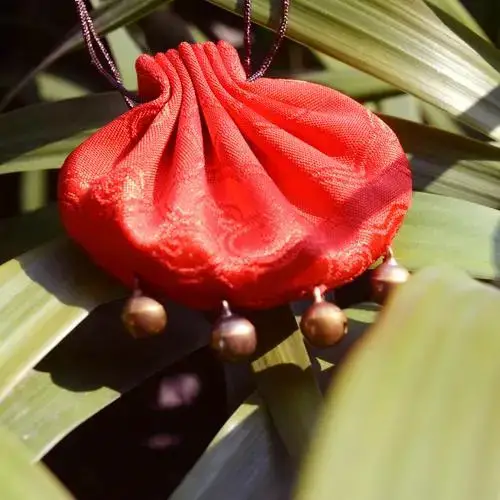
Paper Folded Sachets
Paper folded sachets are a folk handicraft popular during the Dragon Boat Festival, especially in southern provinces such as Jiangsu and Zhejiang. These sachets are made by children and young people to boost their courage and ward off evil spirits. They are created by printing historical and theatrical characters beloved by children onto small square pieces of paper, adding colors, and then folding them into shapes. Finally, they are filled with fragrant powder. Before the Dragon Boat Festival, various herbal ingredients are ground into fragrant powder, including Argy Wormwood Leaf, Camphor Wood, Dahurian Angelica Root, Perilla Leaf, and Qinghao (Artemisia annua). Children use sticks from poplar or pear trees (or bamboo sticks) to flatten the paper and draw or trace the patterns of animals and characters such as lions, tigers, Zhong Kui, the Monkey King, Wu Song, Guan Yu, and Lu Bu. After carving the patterns with a knife and applying ink, they are printed onto white paper and filled with red, yellow, and blue colors. The colors are bright and contrasting. Some patterns are copied from embroidered characters in ancient episodic novels, and they are modified and exaggerated based on children’s preferences and imaginations, while still maintaining a childlike and artistic style. On the Dragon Boat Festival, children often exchange the sachets they made with their siblings or neighboring children. Parents often use colored threads or longevity threads to tie sachets and pouches, hanging them on their children’s chests. This custom of hanging sachets on the Dragon Boat Festival has a slight touch of superstition.
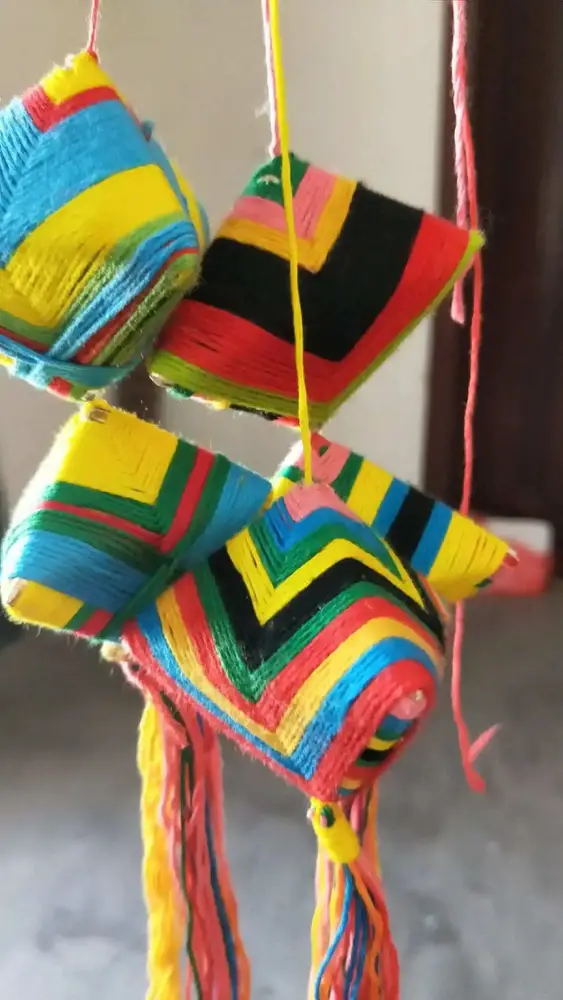
Thousand-Year Sachets
In 2001, a thousand-year-old sachet was discovered inside the second stone tower of Shuangta Temple in Leopards Gully, Huachi County, Gansu province. This tower was built in the tenth year of the Jin Dynasty’s Dading period, approximately 1000 years ago, hence the name “Thousand-Year Sachet.” It is the oldest and most complete embroidered sachet preserved in Qingyang and even in the whole country. The sachet is made of brownish-yellow woven brocade, shaped like a lotus leaf, with a chain made of agate gemstones. It is embellished with traditional edge stitching, using a yellow and white silk thread to decorate the edges. The bottom features an artistic phoenix claw motif and hidden lotus patterns woven into the brocade, enhancing the central sea hibiscus flower. The sea hibiscus flower is intricately embroidered with colorful silk threads, and the leaves are vividly shaped with distinct layers and rich variations. The sachet has an elegant shape, exquisite craftsmanship, fine embroidery, and ingenious design, still radiating vibrant beauty after nearly a thousand years. It is a respectful and devout gift from Buddhists to Buddha statues and pagodas. The appearance of the Thousand-Year Sachet indicates that Qingyang had sachets over a thousand years ago.
Zodiac Sachets
Also known as “Twelve Animal Sachets,” these sachets are made of various colored fabrics representing the twelve zodiac animals. The animals include the rat, ox, tiger, rabbit, dragon, snake, horse, goat, monkey, rooster, dog, and pig. During the Dragon Boat Festival, children wear sachets according to their zodiac sign, believing that wearing the corresponding zodiac sachet brings good luck and protects them from calamities, turning misfortunes into blessings. Therefore, adults often make zodiac sachets matching the zodiac signs of their children, which are worn by the children.
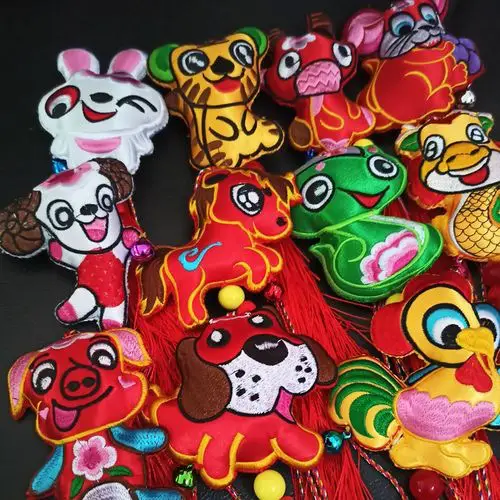
Zong-shaped Sachets
Zong-shaped sachets are primarily used during the Dragon Boat Festival as a way to commemorate the patriotic poet Qu Yuan. They are made by folding thick paper into the shape of zongzi (sticky rice dumplings) and then wrapping them with various colored threads to create geometric patterns. Typically, three to nine sachets are strung together, adorned with colorful tassels at the bottom. The entire string of sachets is vibrant and diverse in shape, creating a splendid appearance. During the Dragon Boat Festival, children and young girls love to wear these zong-shaped sachets as accessories, and some even hang them indoors or on doors to enhance the festive atmosphere. Generally, these sachets are homemade for personal use.
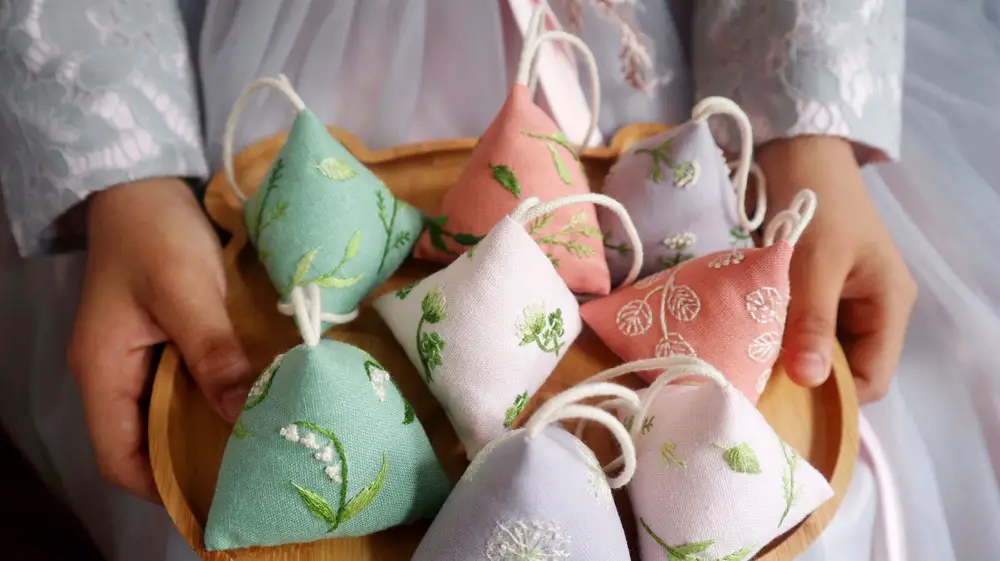
Buyi Ethnic Sachets
The Buyi ethnic group is one of China’s minority ethnic groups, residing in the southwestern part of Guizhou province, specifically in the Buyi-Miao Autonomous Prefecture of Qiandongnan. The Buyi people mainly live in Xingyi City, as well as in Xingyi, Weining, and Libo counties of the Buyi-Miao Autonomous Prefecture of Qiandongnan, with a small population also residing in the eastern part of Xingren City.
The Buyi sachets, also known as “xiang bao,” are made using embroidery and leather. Pange County sachets are renowned for their exquisite patterns, vibrant colors, beautiful shapes, and fine craftsmanship. Each sachet tells a story, reflecting the real-life experiences of the Buyi people and their aspirations for a better life. The patterns on Pange County sachets include flowers, landscapes, animals, and people, all depicted vividly and infused with a sense of daily life. The sachets contain natural ingredients such as aromatic oils, Chinese medicinal herbs, and herbal fragrances, offering various benefits such as repelling mosquitoes and cockroaches, freshening the air, and eliminating odors. With their appealing and convenient designs, sachets make excellent gifts for friends and relatives, as well as decorative and collectible items.
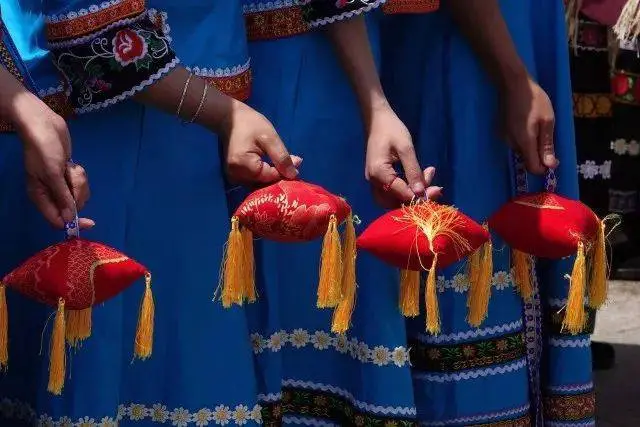
Miao Ethnic Sachets
Miao bone joint handbags are exquisitely embroidered with soaring phoenix patterns, complemented by unique sachet accessories, ensuring no clash of designs. The diamond-shaped sachets are delicately crafted with vibrant colors and meticulous embroidery techniques. They are filled with fragrant herbs and adorned with wooden beads and tassels, combining both beauty and practicality. The sachets also carry the symbolism of warding off evil spirits and offering blessings.
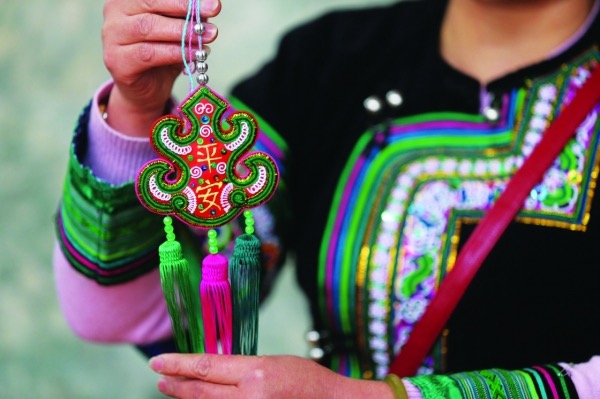
Xibo Ethnic Sachets
Xibo ethnic purses, also known as sachets or fragrance bags, are called “fado” in the Xibo language. They are small bags carried or hung in Xibo households, containing small items or aromatic substances. Made by Xibo women, these sachets are a folk art form based on embroidery and appliqué techniques. They possess rich ethnic characteristics.
Early versions of Xibo purses were primarily made of animal skins, larger in size, and had rough craftsmanship, serving mainly utilitarian purposes. With the societal and historical changes, especially during the late Ming and early Qing dynasties (around 1644 AD), when the Xibo ethnic group migrated with the Manchus, the purses gradually became smaller in size and were made with coarse fabrics like rough cloth and silk. They were embroidered with patterns, and at the same time, the Xibo people had primitive worship and shamanistic beliefs. When making the purses, they regarded many flowers and animals in nature as divine beings. Consequently, they transformed auspicious natural elements into purely decorative and three-dimensional ornaments, giving rise to the unique style of Xibo purses.
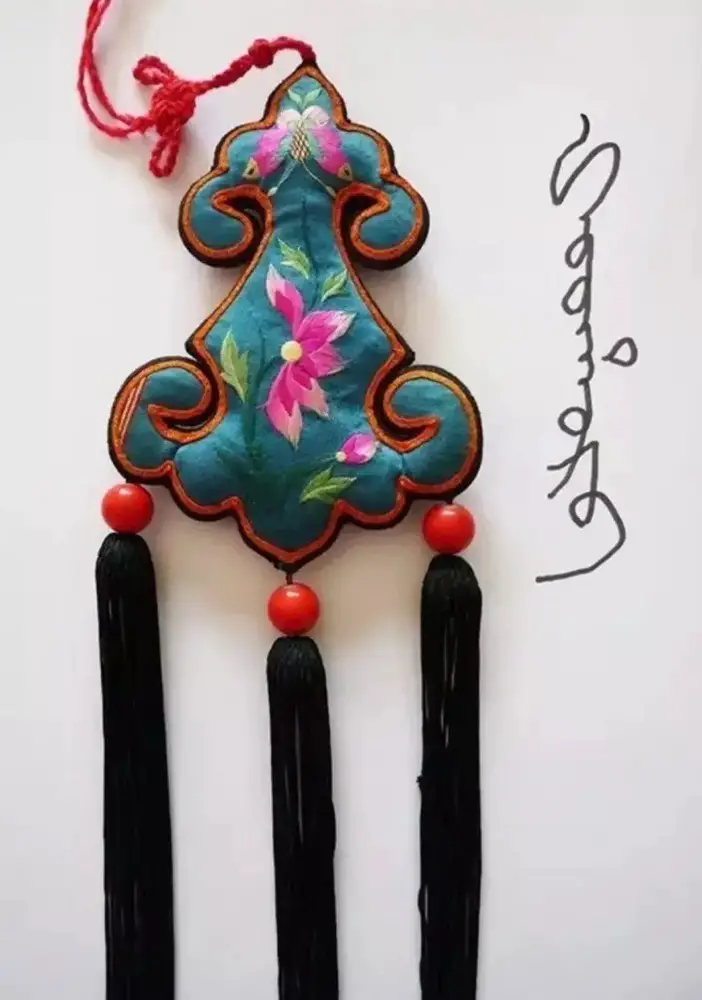
Manchu Ethnic Sachets
Manchu sachets have a long history. Manchu ancestors, the Jurchen people, often roamed deep forests, interacting with birds and animals, and carrying pouches made of animal skins around their waists, containing food and tightened with thin leather belts. With the development of Jurchen society, as the ancestors of the Manchu people ventured out of the mountains and began an agricultural lifestyle, the leather bags evolved into cloth bags. These delicate and exquisite accessories were made from fabrics such as satin, gauze, silk, and brocade. They were embroidered with patterns of flowers, birds, insects, and fish, becoming the later-day sachets.
Manchu sachets, as one of the traditional folk crafts of the Manchu people, embody the profound cultural heritage of the Manchu culture over thousands of years. They are replete with rich connotations and are a significant accessory in the attire of Manchu costumes during the Qing Dynasty. The Phoenix City Manchu sachets contain wild and natural fragrances, such as incense grass, which can retain their aroma for several years. Carrying them not only helps repel dirt and odor, refreshes the mind, and boosts the immune system but also serves as a pest repellent when hung indoors. The unique characteristics of the Phoenix City Manchu sachets, with their exquisite craftsmanship and alluring fragrances, have made them irresistible and highly sought-after by domestic and international tourists and collectors.
As a settlement of the Manchu people, the tradition of making and wearing sachets in the Dandong region can be traced back to the period before and after the Manchu people’s entry into the customs, especially in the 26th year of the Kangxi reign (1687 AD). Since then, the custom has been passed down through generations in the folk culture of the Dandong region for over 300 years.
Manchu sachets belong to the category of embroidered handicrafts, primarily using satin as the main material. They feature geometric shapes, plants and animals, objects, and other motifs, all meticulously embroidered with birds, flowers, insects, auspicious phrases, characters from traditional operas, mythical legends, auspicious birds, auspicious animals, facial masks, and antiques. These motifs are often adorned with decorations such as pearls, agate, amber, jade, and tassels. Manchu sachets are widely used in romantic relationships, gifts for family and friends, collections, and decorative purposes. Particularly during the Dragon Boat Festival celebrations, sachets are employed to ward off calamities, bring good fortune, and have become iconic folk craft items with distinct characteristics and great popularity. Manchu sachets come in different varieties, broadly categorized into two types: sachets for fragrances, filled with aromatic herbs that retain their scent for decades, and practical sachets for carrying items such as cigarettes, money, and jewelry. The sizes of Manchu sachets also vary, ranging from the smallest at 1.5 cm × 1.5 cm to the largest at 30 cm × 24 cm.
As one of the existing “living cultural” elements of the Manchu culture, Manchu sachets hold significant historical, artistic, and practical value. Currently, the Phoenix City Manchu sachets have developed into five major product categories, comprising more than 20 different varieties. They have become emblematic folk crafts in the festive activities and tourism souvenirs of the Dandong region. They have received numerous national and provincial awards for ethnic and folk arts and crafts, and in 2007, they were listed as provincial-level intangible cultural heritage items.

She Ethnic Sachets
She ethnic sachets, also known as “rong chou,” “xiang ying,” or “pei wei,” are traditional folk embroidered crafts created by She ethnic women in ancient China.
She culture has a long and rich history, and sachets have been passed down through generations among the She ethnic people. To this day, the art of making She ethnic sachets has a history of thousands of years and has developed its unique artistic style with distinct regional characteristics. They are both rough and bold, as well as delicate and graceful. They exhibit vibrant and colorful aesthetics, as well as pure and elegant simplicity. The designs range from expressive brushstrokes to meticulous fine strokes.
In the eyes of the modest and hardworking She people, sachets carry symbolic meanings of warding off evil spirits and representing auspiciousness and good fortune. For example, lotus sachets symbolize fertility and interconnectedness, while pomegranate sachets represent prosperity and joy.
Strings of well-crafted sachets embody the ancient wisdom of the She ethnic group, convey a strong sense of local sentiment, and carry sincere wishes for a better life from the She people.
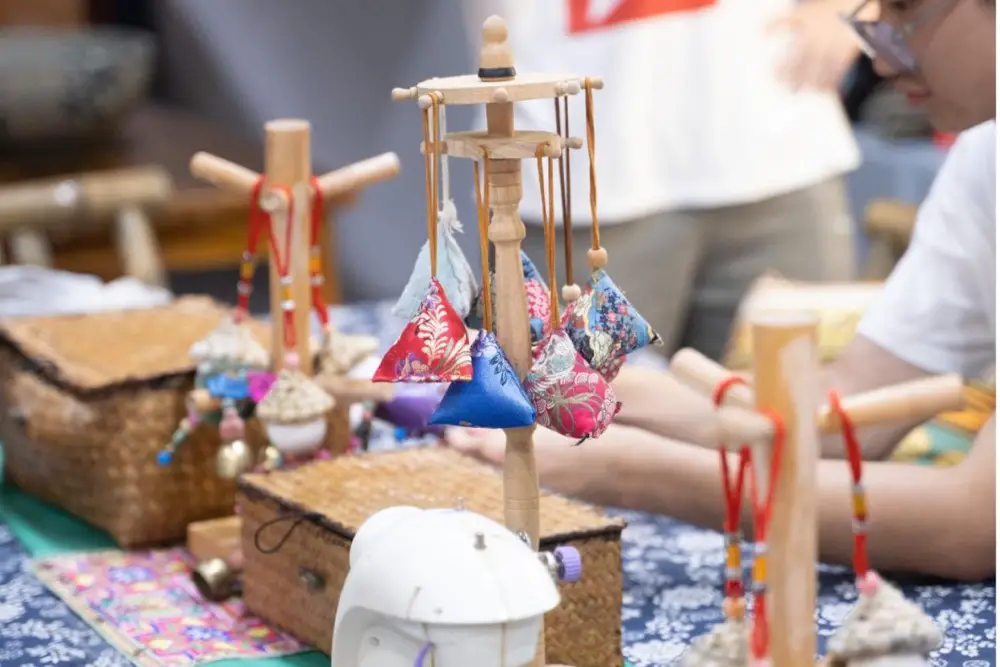
Qiang Ethnic Sachets
Qiang ethnic sachets often feature a goat’s head motif. In traditional agrarian society, making sachets provided Qiang women with the best opportunity to showcase their needlework skills. The quality of the patterns and embroidery work reflects the expertise of the creators.
When Qiang girls get married, they traditionally present handmade Yunyun shoes and sachets to their husbands. Qiang people believe that the bride’s sachet brings good luck and helps ward off evil spirits.
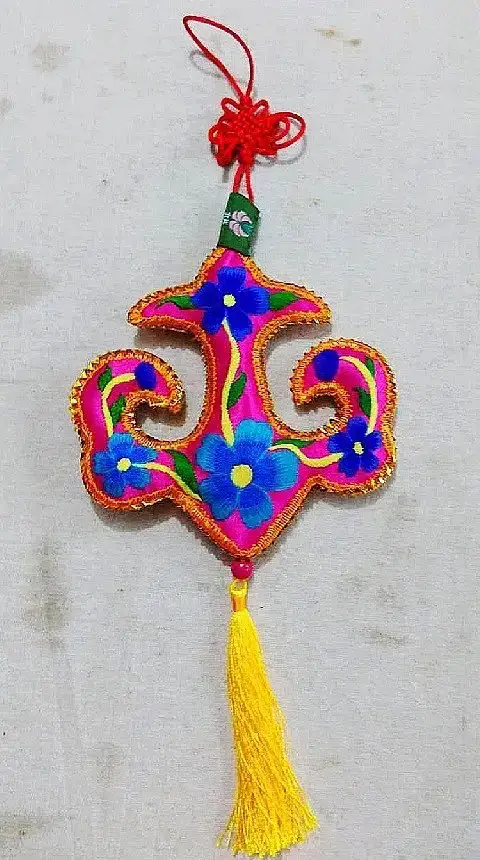
Oroqen Ethnic Sachets
The Oroqen ethnic group is one of the smallest ethnic minorities in Northeast China. According to the “China Statistical Yearbook 2021,” the Oroqen population is 9,168. Oroqen sachets are usually made of deer skin and come in bat-shaped or apple-shaped designs. They are considered ornaments for young girls.
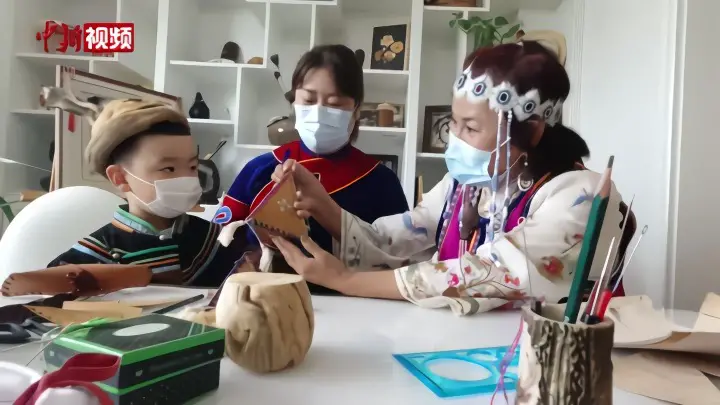
Yao Ethnic Sachets
The Yao ethnic group is one of the ethnic minorities in China with a long history. The northern part of Guangdong Province is one of the main areas where the Yao people reside, and Yao costumes showcase the richness and unique style of their ethnic culture. Yao women are skilled in embroidery from a young age, and the craft has been passed down through generations, demonstrating their exquisite craftsmanship and distinctive techniques.
The Lian’nan Yao embroidery sachets can have different symbolic meanings, including:
Octagonal sachets: Octagonal sachets, also known as “Emperor’s seal,” are said to originate from a Yao girl who saved an emperor from a tiger’s attack. In gratitude, the emperor left his seal, which bore the tiger’s paw print, on the back of the girl’s dress. Over time, the girl embellished the paw print with embroidered patterns, and it became known as the “Emperor’s seal.”
Auspicious sachets: These sachets combine the traditional Yao embroidery of “wan zi wen” (thousands of characters) and the pan-wang seal. The “wan zi wen” symbolizes good luck and smoothness, while the pan-wang seal represents the Yao people’s reverence for the sun and the moon.
Fu (fortune) character sachets: These sachets combine the traditional Yao embroidery with the Fu character, a symbol of happiness and good fortune. They are considered excellent home decorations.
Health-enhancing sachets: Yao embroidery incorporates various floral and animal patterns inspired by nature. Abstract and realistic depictions of flowers, plants, trees, sun, moon, and rivers embellish the sachets, while small copper coins are attached for warding off evil spirits. These sachets can be hung on children’s schoolbags or worn on the chest, providing protection and bringing good luck.
Pan-wang seal Yao embroidery sachets: These sachets feature different styles of pan-wang seals with octagonal patterns. The octagonal shape represents the sun and brightness, symbolizing beauty and wealth. Yao embroidery sachets primarily use red or deep red plush threads and are adorned with yellow, white, green, blue, and pink silk threads as edging, creating a striking contrast with the base fabric. The embroidery is vibrant, diverse, and rich in distinctive ethnic characteristics.
The Lian’nan Yao embroidery sachets are infused with unique needlework techniques, reflecting the craftsmanship and deep sentiment of Yao women. They symbolize the people’s aspirations for beauty and prosperity.
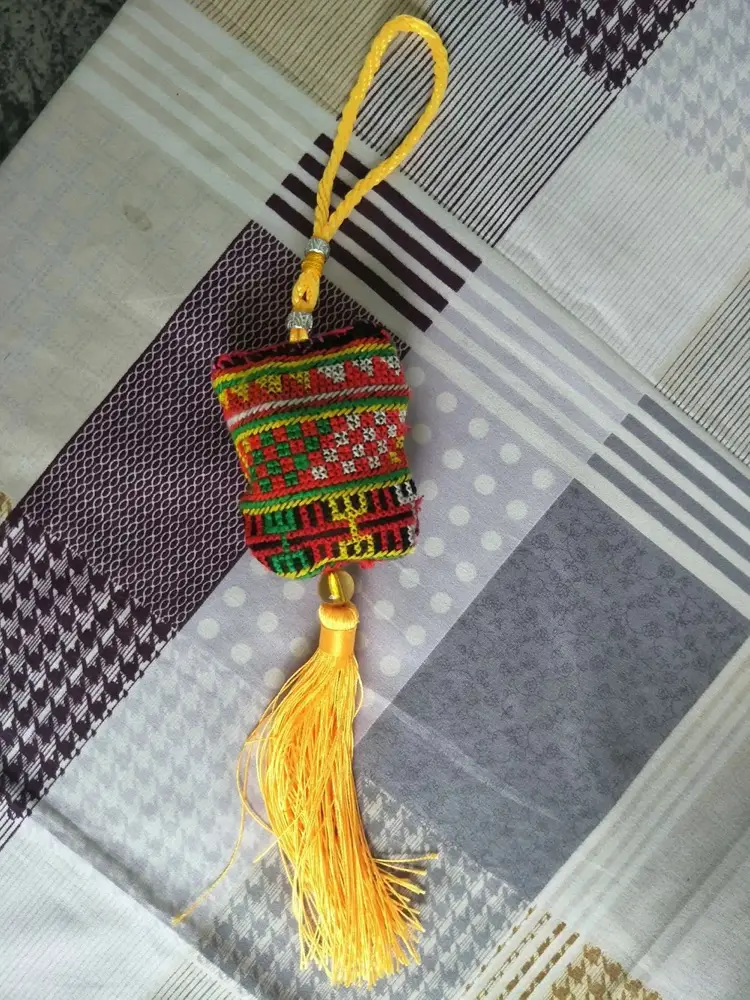
Dong Ethnic Sachets
Dong ethnic sachets are distinguished by their embroidery, which showcases the unique Dong embroidery technique. Dong embroidery, as the name suggests, is created by Dong people with one stitch at a time on Dong cloth. It has a distinctive style that is natural, simple, and generous, with the Three Dragons embroidery being a representative example. It embodies the wisdom of the Dong ethnic group and serves as a witness to the historical and cultural development of the Dong people. The patterns in Dong embroidery mainly feature flowers, birds, and geometric designs, and some also depict figures and architectural patterns. Modern Dong embroidery incorporates bold innovations and includes fashionable elements. Applying these elements to sachets gives Dong ethnic sachets a unique sense of elegance, sophistication, and simplicity.
Like other sachets, the fragrance used in Dong ethnic sachets mainly consists of aromatic ingredients such as calamus, grassleaf sweetflag, white atractylodes, Chinese sweetflag, and patchouli. These ingredients not only repel mosquitoes but also provide a refreshing and uplifting effect while purifying the air and preventing diseases, bringing joy to the wearer.
Due to the time and effort required for handmade embroidery, Dong ethnic sachets are often used as decorative accessories, commemorative items, or tokens of affection in romantic relationships. In this era of mass production, the handmade Dong embroidery sachets stand out for their preciousness and craftsmanship.
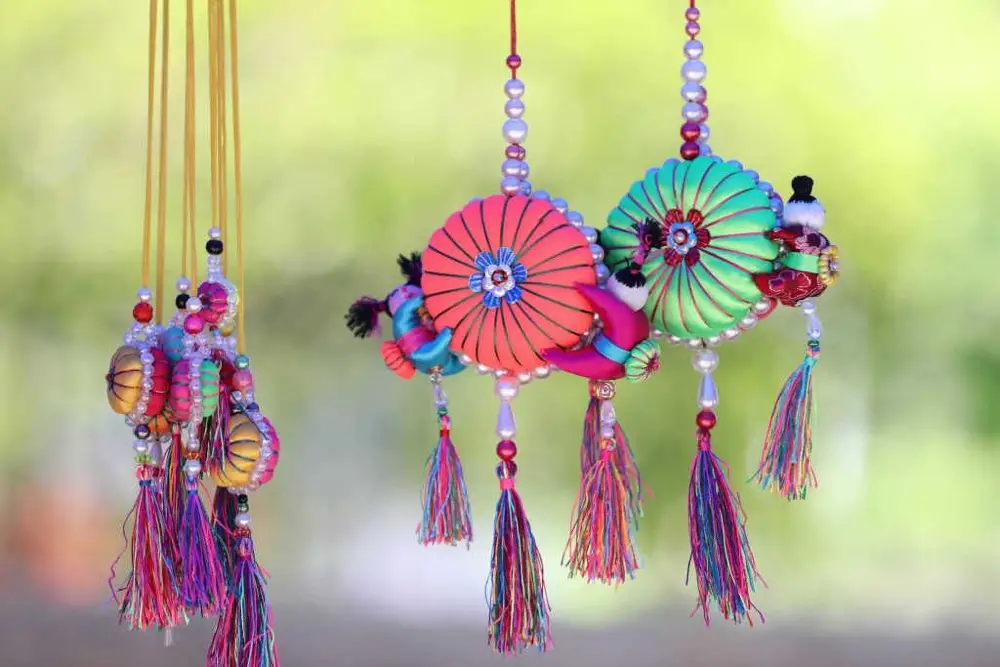
Tu Ethnic Sachets
Tu ethnic sachets are exquisite and delicately crafted, showcasing extraordinary intangible cultural heritage skills. They come in various patterns and shapes, making them irresistible. Examples include auspicious peaches, lotus flowers symbolizing good fortune, peony sachets, zodiac animal designs, and majestic lions.
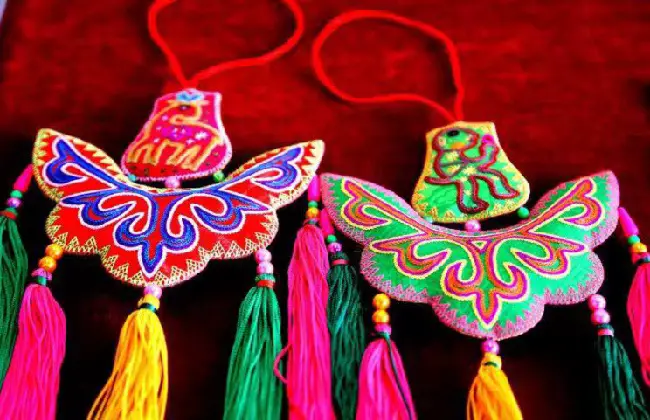
Daur Ethnic Sachets
The Daur people have a tradition of offering tobacco during important occasions. In the past, the Daur people cultivated and processed their own tobacco, so they carried smoking accessories and their self-grown tobacco with them. When encountering significant events, they would perform a tobacco offering ceremony. Sachets were used not only to store tobacco but also to hold silver coins or aromatic substances. They were physical objects for expressing emotions and symbols of identity.
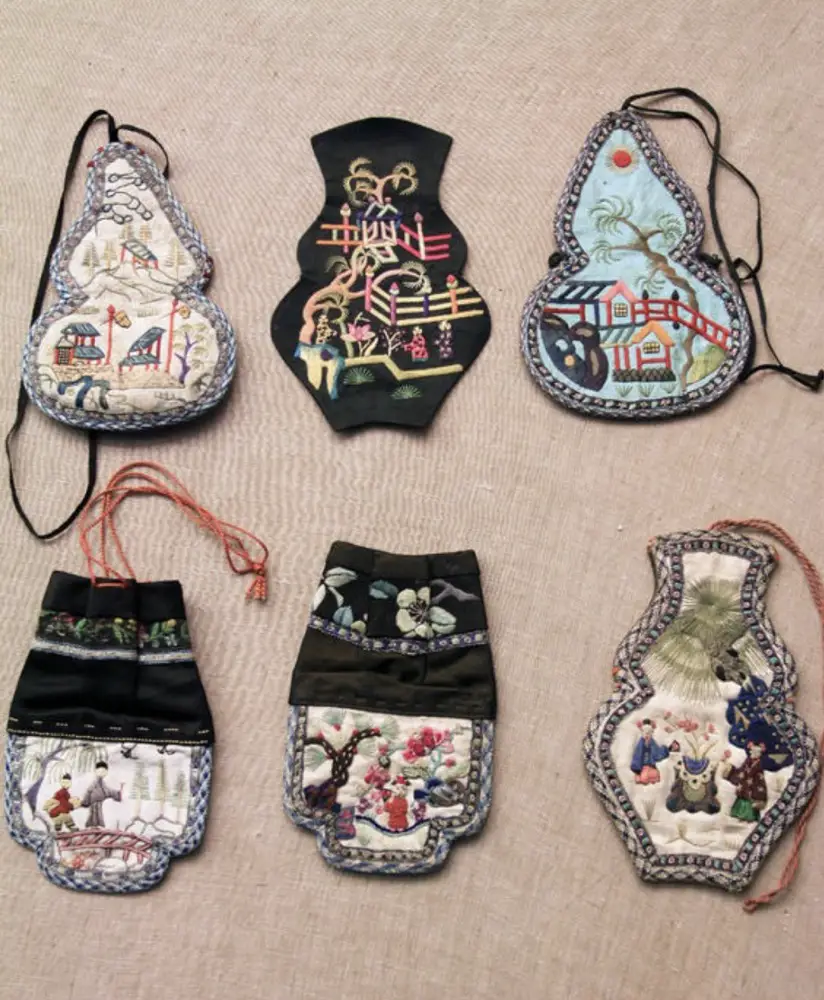
Tujia Ethnic Sachets
Among the young men and women of the Tujia ethnic group in western Hunan, sachets are tokens of affection. The sachets usually have a bleached silk fabric as the outer layer and red fabric as the inner layer, embroidered with patterns such as “Jingyu Xishui” (meaning “caution when playing in water”). If a young man receives a girl’s sachet, it means he has won her heart, making his marriage proposal almost certain.
Zhuang Ethnic Sachets
During the Zhuang ethnic group’s “San Yue San” Festival and the Qingming Festival, traditional Chinese medicine has introduced the “Spring Outing Series” herbal sachets based on the characteristics of the seasons. The sachets, known as “Me Mie,” are shaped like a small person with outstretched limbs embracing a round bead. They are filled with various medicinal herbs such as mugwort, aromatic herbs, Schisandra peel, and Centella asiatica. These sachets have special meanings associated with warding off evil spirits, longevity, seeking blessings, peace, love, and expressing emotions. They are the favorite auspicious ornaments exchanged and worn by the Zhuang people in the Baise region during wedding customs and various festive occasions.
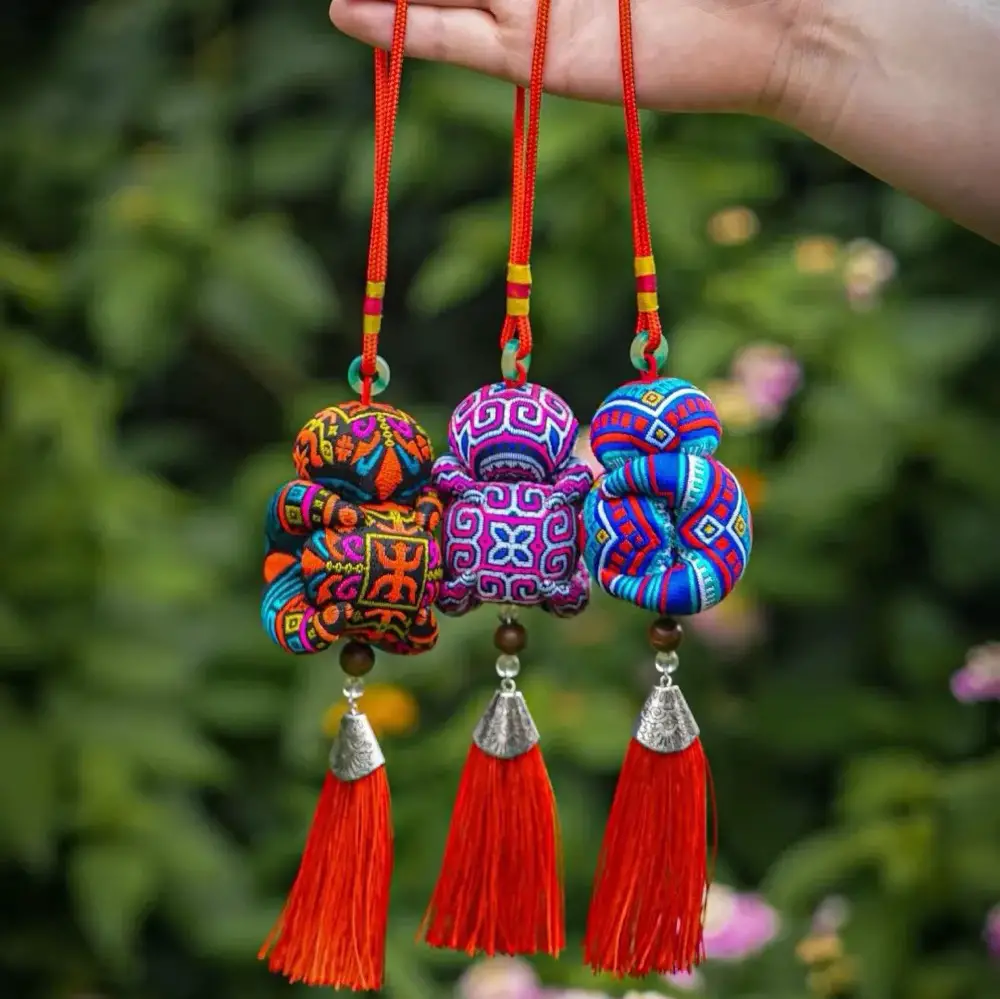
Chinese sachet in Chinese culture
In Chinese folklore, there is a custom of gifting sachets to friends and relatives. It is believed that the bride, as a bearer of joy, can ward off evil spirits and toxins with the sachets she makes herself. Therefore, during the Dragon Boat Festival in the first year of her marriage, the newlywed bride must sew and distribute sachets to friends and relatives. On average, she needs to give away one or two hundred sachets. Apart from giving them to friends and relatives, they are mostly given to children to wear. This practice reflects the care of the older generation for the younger generation, hoping for their smooth growth and protection from evil spirits. Sachets can also be given to elders as a sign of respect and filial piety.
As for the meaning behind gifting sachets to lovers, it holds even deeper significance, with each stitch carrying infinite tenderness. In the past, women would sew sachets for their children or lovers when they were about to travel far away. This was both to bless their safe journey and to remind them that someone was waiting for them at home, urging them to return soon. However, these heartwarming customs are less common in modern times.
One reason is that with advancements in medicine, the function of warding off evil and toxins through sachets has diminished. Additionally, in today’s fast-paced industrial and commercial society, many women have busy lives and are engaged in professional work, leaving them with little time to study traditional needlework. As a result, there is a large production of sachets available for sale around the Dragon Boat Festival. Although the patterns on these sachets are beautifully embroidered, they may lack the traditional charm and warmth due to their mass production. Moreover, most of them use synthetic fragrances that do not last long. The essence of traditional sachets, which once brought joy and warmth to people’s lives, has somewhat been lost.
Snatching sachets
Snatching sachets is a folk custom among the Han ethnic group, popular in southern Shaanxi province. Prior to the Dragon Boat Festival, young girls meticulously sew sachets using colored fabric and embroidery thread, shaping them like zongzi (sticky rice dumplings), tigers, golden deer, butterflies, swallows, peacocks, gourds, longevity peaches, plum blossoms, or other animals and plants. These sachets are adorned with colorful tassels and filled with fragrant herbal ingredients. It is said to be a continuation and development of the ancient tradition of “Ai Hu” (literally “Ai Tiger”).
During the festival, young girls wear the sachets on their chests and walk through the streets, attracting attention. Young men, selecting their targets, unexpectedly snatch the sachets from the girls’ hands and quickly run away. In this situation, the girls are not angered but rather delighted because their handiwork is appreciated by the opposite sex. If a girl’s sachet is not snatched by anyone, she may feel disappointed.
what are Chinese sachet made of?
Chinese sachets, also known as “xiangbao” or “xiangdai,” are made of various materials. The choice of materials depends on personal preferences, regional traditions, and the purpose of the sachet. Here are some common materials used in Chinese sachets:
Fabric: Traditional Chinese sachets are often made of silk fabric, which is considered auspicious and luxurious. However, other fabrics such as cotton, satin, brocade, or organza are also used.
Thread: High-quality thread is used for sewing the sachet. Silk thread is commonly used for its durability and fine appearance.
Fillings: The fillings of Chinese sachets typically consist of a combination of fragrant materials, herbs, and spices. Common fillings include:
Fragrant herbs: Traditional Chinese medicinal herbs are commonly used, such as mugwort (Ai Cao), patchouli (Huo Xiang), and sandalwood (Tan Xiang).
Aromatic spices: Various spices and seeds are used for their fragrance, such as cloves (Ding Xiang), cinnamon (Rou Gui), and dried citrus peel (Chen Pi).
Flowers: Dried flowers such as lavender, rose petals, or dried chrysanthemum are used to add a pleasant aroma.
Essential oils: In modern sachet-making, essential oils are sometimes added to enhance the fragrance.
Decorations: Chinese sachets are often adorned with decorative elements, such as intricate embroidery, beadwork, sequins, or tassels. These decorations add beauty and charm to the sachets.
It’s important to note that the specific materials used in Chinese sachets can vary based on regional customs, cultural preferences, and individual creativity. Different regions in China may have their unique variations and materials specific to their local traditions and beliefs.
what are Chinese sachet used for?
Prevention and treatment of epidemics: Sun Simiao’s “Qian Jin Yao Fang” states, “Avoiding epidemic qi keeps people from being infected.”
Protection against mosquito bites: During the summer when mosquitoes are abundant and there were no mosquito repellents in ancient times, and most households did not have mosquito nets, people would spend more time outdoors. Children, with their tender skin, were more susceptible to mosquito bites on their heads, faces, and necks. Therefore, they would wear sachets around their necks and chests.
Prevention of snake bites: Southern regions have a humid climate and are home to many venomous snakes. People living in mountainous areas would wear sachets containing realgar to prevent snakes from entering their beds. Snakes would stay away from the scent of realgar. In the legend of Bai Niangzi, when she drinks realgar wine, her true form is revealed. Therefore, it is believed that small snakes would also be repelled by realgar.
Protection against impurities and turbidity: During the rainy season in summer or in areas with little human activity and abundant vegetation, there may be decaying organic matter, producing impurities and turbidity in the air. Wearing sachets in such areas or during seasons with high impurities and turbidity is believed to have a purifying effect.
Absorbing sweat: In the book “Sui Shi Guang Ji” by Chen Shiliang, it mentions the use of colored sachets made for the Dragon Boat Festival, which are filled with cotton and worn as ornaments. It is said that they serve the purpose of absorbing sweat.
Freshening indoor air.
The beginning of May is the spring-summer transition period when insect pests reappear, and epidemics may occur. It is important to disinfect and prevent diseases during this time. Folk artisans make sachets containing medicinal herbs to wear, which not only serve as disinfectants, insect repellents, and air fresheners, but also express people’s wishes for the health and safety of their children. The sachets add a touch of auspiciousness and are small, exquisite, and fragrant, providing multiple benefits. Therefore, sachets are typically worn starting from early May.
what are Chinese sachet symbolizes?
Dispelling evil and seeking blessings is the eternal theme of sachet culture. The metaphorical symbolism and expressive characteristics are the distinctive artistic features of sachets. The patterns and designs of Qingyang sachets are highly exquisite and carry rich symbolism: tigers and lions symbolize bravery and protection against evil; paired fish, butterflies, and dragons symbolize love, union, and fertility; lotus flowers, water lilies, peonies, and plum blossoms represent the purity and sweetness of women; magpies perching on plum trees and bees collecting nectar symbolize men; the presence of gourds, pomegranates, and multi-seeded fruits represents the wish for abundant offspring and good fortune; the homophonic names of jujubes, peanuts, longans, and lotus seeds convey the wishes for early childbirth and prosperity. The “Playful Old Age” design, featuring cats and butterflies frolicking among peonies, is meant for elderly individuals to enjoy a life filled with joy. The “Blessing and Longevity Doll” design features an adorable doll surrounded by bats and peaches, symbolizing good health and safety for children.
Wearing sachets is also carefully considered. Older people, in their pursuit of disease prevention and health, often prefer sachets shaped like plum blossoms, chrysanthemums, peaches, apples, water lilies, dolls riding fish, dolls embracing roosters, or intertwined lotus flowers, symbolizing a life filled with the fragrance of flowers, good fortune in all endeavors, harmonious marriages, and family unity. Children, on the other hand, prefer sachets depicting birds and animals, such as tigers and leopards, monkeys playing musical instruments, and chickens chasing rabbits. Young adults pay great attention to the choice of sachets, especially during the passionate stage of love. Romantic girls often create unique sachets well in advance and present them to their beloved before the festival. When young men wear sachets gifted by their loved ones, they naturally draw comments from their peers, praising the dexterity of their partners.
In rural Qingyang, various themes including flowers, trees, insects, birds, animals, celestial bodies, architecture, geometric patterns, and figures can be embroidered on sachets. Talented folk artists bring to life intricate designs of dragons, phoenixes, goldfish, baby tigers, lions, snakes, toads, geckos, centipedes, scorpions, and more using just needles, threads, and scissors. They present these vivid patterns to the world, allowing people to appreciate and enjoy them in the fragrant world of sachets, serving as a testament to the artists’ skills and expressing the beautiful aspirations deep within people’s hearts.
how to make Chinese sachet?
Making sachets is a traditional folk craft and a creative handmade activity. Sachets are filled with various aromatic herbs and spices, such as mugwort, cloves, and lavender, releasing a rich fragrance. They not only help eliminate odors and purify the air but also have certain health benefits. In this article, we will introduce the materials, steps, and precautions for making sachets.
To make sachets, you will need the following materials:
Fragrant ingredients: Choose herbs or spices like mugwort, cloves, lavender, etc., according to your personal preference.
Fabric: Select breathable and colorfast fabric of your choice.
Thread: Use strong and durable thread for sewing.
Filling: Fillings such as fine sand, wood shavings, or camphor leaves can be used to make the sachets plump.
Sewing tools: Needles, scissors, and other sewing tools.
First, rinse the selected fragrant ingredients in clean water, then steam them in a steamer for 10-15 minutes to extract the fragrance. After steaming, remove the fragrant ingredients and squeeze out the excess water using a clean towel. Next, fold a rectangular piece of fabric in half to form two layers, then cut out the shape of the sachet according to your preference.
Place the steamed fragrant ingredients into the sachet body, taking care not to overfill it to prevent the sachet from bursting. Sew the sachet body together, leaving a small opening. Insert the filling into the sachet, then sew up the opening to complete the sachet.
Here are a few points to note when making sachets:
- Choose fragrant ingredients based on personal preference and seasonal factors. For example, in summer, you can choose refreshing fragrances like mint or lemon, while in winter, you can opt for rich scents like cinnamon or cloves.
- Select fabric that is soft, breathable, and avoid using synthetic materials that may affect the effectiveness of the sachet.
- Ensure sufficient steaming time to fully extract the fragrance from the ingredients. After steaming, avoid soaking the fragrant ingredients in water for too long to prevent the loss of fragrance.
- Maintain even stitches when sewing the sachet to avoid crooked or skipped stitches, ensuring both the aesthetics and functionality of the sachet.
- After making the sachet, place it in a well-ventilated and dry area to air-dry, avoiding direct sunlight and damp environments to maintain its effectiveness and longevity.
Making sachets is a fun handmade activity that not only enhances your crafting skills but also allows you to experience the joy of creating fragrant items. Through the process, you can enjoy the delightful aroma and appreciate the beauty of nature. You can also give sachets as gifts to convey your love and care to family and friends. Making sachets is not only a craft skill but also a reflection of cultural heritage and folk customs.
Basic Type:
Start by selecting suitable fabric and cutting it into the basic shape. Then choose the appropriate embroidery thread based on the cut fabric. Fold the rectangular fabric in half with the inside facing inwards. After sewing the fabric edges together, flip it over and sew the other side. Use a straight stitch to sew the opening, sew a complete circle, and tighten the thread end. Fill the sachet with a moderate amount of fragrance and then stuff it with cotton. Once filled, tighten the opening and sew the edges to form the shape. Attach a tassel at the bottom of the sachet and use glue to attach cut leaves and ribbons at the top. This completes a basic-shaped sachet resembling a chicken heart.
Realistic Shape:
For sachets with realistic shapes, begin by designing the pattern and cutting paper as a template. Glue the paper template onto the back of the fabric. Embroider the pattern on top of the fabric, then sew together two embroidered fabric pieces with their fronts facing each other. When sewing, ensure that the gaps are not too large. Halfway through sewing, stuff the sachet with fragrance and cotton.
Next, create decorative ribbons by securing them at the bottom. Thread beads onto the ribbon, tie a Chinese knot, and attach a tassel. This creates a sachet symbolizing happiness.
Wrapping Type:
Another method is the wrapping type sachet. Start by cutting two square pieces of paper and cover them with silver foil as the base color. Apply glue on the edges of both square silver card papers and stick them together to form an octagonal shape. Begin by attaching the thread end on the top, securing it inside the card paper. Then start wrapping the thread around each edge of the octagon. Switch to yellow thread for wrapping. This creates a wrapped sachet with an octagonal outer shape and a yin-yang symbol inside.
Chinese Doll Sachet:
Stuff cotton into a small piece of pantyhose, shaping it into a round ball. Tighten it with black thread and mark the desired hair position with a dotted line using a marker. Use black thread to sew diagonally across the circle, leaving enough length for the hair. Repeat until the desired hair length is achieved. Secure the hair with thread or tie a red bow.
Next, create eyes and sew a mouth using embroidery thread. Cut a rectangular piece of fabric for the body and start sewing the edges. Cut an opening and sew the prepared head, ensuring the thread ends are not visible. Fill the sachet with fragrance and tightly stuff it with cotton. Use a crochet hook to fill the gaps at the four corners with cotton. Sew it closed, then cut another piece of fabric for a bellyband. Decorate the fabric with sequins or embroider preferred patterns. Apply glue or sew it onto the back. If cotton and fragrance are not available, dried flower petals and artificial fragrance can be used as substitutes.
Hebao Vs xiangbao
Arexiangbao and Hebao the Same Thing?
When people hear the term “hebao” nowadays, they immediately associate it with a wallet. However, in ancient times, a hebao was not used for carrying money but rather had similarities toxiangbao.
Before the late Ming Dynasty and early Qing Dynasty, the term “hebao” encompassed both small miscellaneous storage and fragrance pouches. It was not until the mid to late Qing Dynasty that these two functions distinctly separated into Hebao for money andxiangbao for storing fragrant materials. In ancient times, a “hebao” was actually used to hold fragrances, thus also known as fragrance pouches orxiangbao. They were typically tied to undergarments and used for personal fragrance, making them very intimate items. It was only in the late Ming and Qing Dynasties that dedicated Hebao for holding small silver coins and other small items emerged. The materials used varied from simple coarse cloth used by the common people to fine silk used by the privileged.
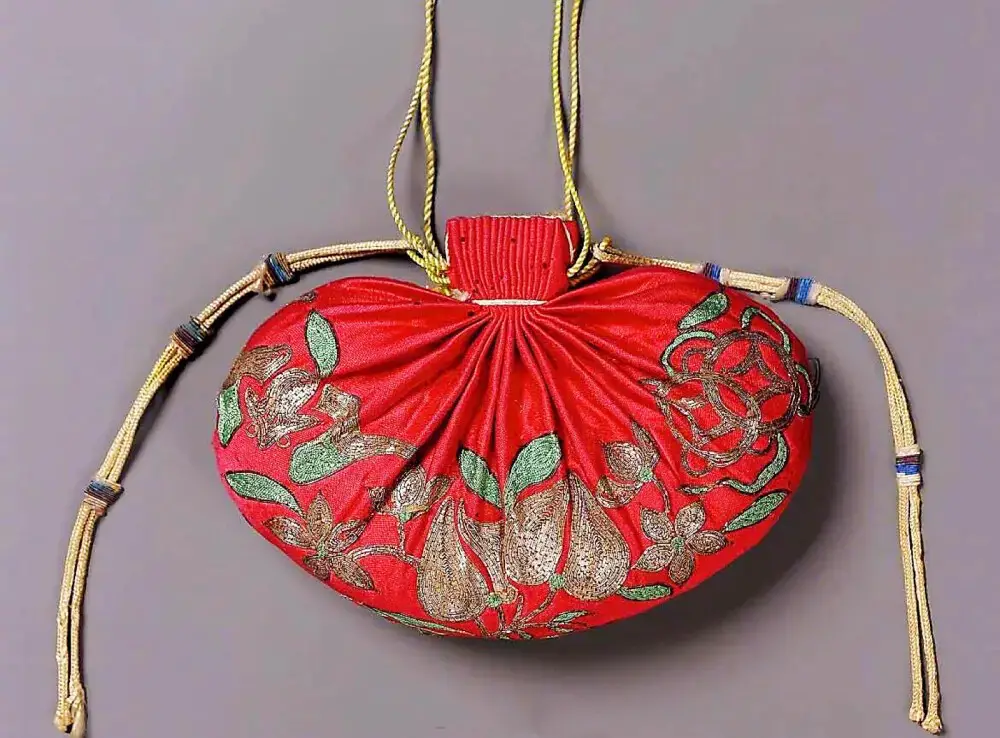
Differences between Hebao and xiangbao:
What are xiangbao?
Perfume pouches are embroidered craftworks made by stitching colorful threads onto silk fabric to create various patterns. They are sewn into different shapes such as round, square, oval, or peach-shaped pouches, varying in size. The pouch consists of two pieces of silk sewn together with a hollow center, and it is filled with finely ground fragrant herbs. They are often adorned with silk cords for hanging and may have colorful tassels or bejeweled pendants. They are typically worn at the waist or hung on beds or carriages.
What are Hebao?
Hebao originated from fragrance pouches but gradually developed into distinct items. In ancient times, people wore loose-fitting clothes without pockets or the habit of carrying exquisite bags as modern individuals do. To solve this problem, they created Hebao. Hebao are small, open-mouthed bags used to hold various small items, including coins. They are similar to the bags carried by women today, but in ancient times, they were usually attached to belts or sashes.
Differences between xiangbao and Hebao:
Function:xiangbao are used for personal fragrance, while Hebao are used to hold money and other small items.
Contents:xiangbao contain fragrant substances such as aromatic herbs and spices, whereas Hebao hold money and other items.
Style: Hebao typically have an open mouth, while xiangbao are sealed.
Conclusion:
Perfume pouches and Hebao have distinct functions and purposes in Chinese culture.xiangbao are decorative items filled with fragrant materials, used for personal fragrance and hung as charms, while Hebao are small bags primarily designed to hold money and other small items. Understanding the historical and cultural significance of these items helps us appreciate the diversity and craftsmanship of traditional Chinese accessories.
Chinese sachet VS jade pendant
Chinese sachets and jade pendants are both traditional cultural items in China, but they have different characteristics and purposes.
Chinese Sachet:
Chinese sachets, also known as “xiangbao” or “xiangdai,” are small cloth bags filled with aromatic herbs, spices, or other materials.
Sachets are often decorated with intricate embroidery, patterns, and symbols that hold symbolic meanings and cultural significance.
They are believed to have protective and auspicious properties, such as warding off evil spirits, promoting good luck, and attracting positive energy.
Sachets are commonly worn or placed in various settings, such as on clothing, accessories, in cars, or around the home, to benefit from their fragrant scents and symbolic powers.
Jade Pendant:
Jade pendants, known as “yu pendant” in Chinese, are decorative ornaments made from the precious gemstone jade.
Jade has a special significance in Chinese culture and is highly valued for its beauty, durability, and spiritual qualities.
Jade pendants often come in various shapes and designs, such as animals, flowers, or abstract forms, and can be carved with intricate details.
Jade is believed to possess protective and healing properties, as well as symbolize purity, wisdom, and harmony.
Jade pendants are typically worn as jewelry or used as decorative items, representing personal style, cultural heritage, and a connection to nature.
While both Chinese sachets and jade pendants have cultural and symbolic meanings, they differ in their materials, forms, and uses. Sachets primarily focus on fragrance and symbolism, offering protection and auspicious blessings, while jade pendants highlight the beauty and spiritual qualities of the jade stone itself, serving as personal adornments and artistic expressions.
Modern Adaptations
While the traditional art of making Chinesexiangbao remains cherished, there have been modern adaptations to meet contemporary preferences. Some pouches now come in different shapes, sizes, and designs, catering to individual tastes and fashion trends. Additionally, synthetic fragrances or scented beads are sometimes used instead of natural materials to extend the lifespan of the scent.
Preserving Cultural Heritage
Chinesexiangbao represent more than just beautiful accessories; they are an embodiment of cultural heritage and traditional craftsmanship. They serve as a reminder of China’s rich history, beliefs, and customs. Efforts are made to promote and preserve this cultural tradition through workshops, exhibitions, and the passing down of knowledge from one generation to another.
Conclusion
Chinesexiangbao are not only objects of beauty and fragrance but also bearers of cultural significance and symbolic meaning. They connect people to China’s ancient traditions and offer a glimpse into the country’s intricate craftsmanship. Whether used for personal enjoyment, decorative purposes, or as meaningful gifts,xiangbao continue to be cherished and celebrated as an enduring part of Chinese culture.